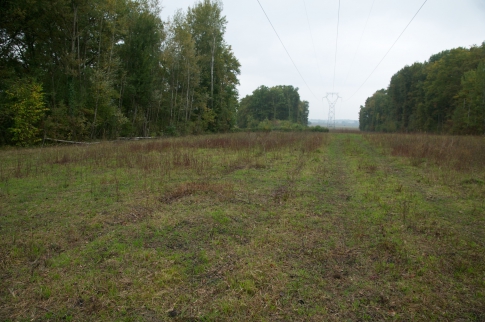News
2015-10-15
Meeting on the Foręt d’Orient site (F)
On October 15th 2015, the LIFE partners gathered on the site of Forêt d'Orient, in Aube Department (10).
The Mayor of the village of Brienne-la-Vieille, Th. Tournebize (Scientific Director of the Regional Natural Park of the Forêt d'Orient), Johan Brouillard (project manager of the Conservatory of Natural Areas Champagne Ardennes), the shepherd (Mr M. Bouvin), the LIFE team and representatives of RTE.
Restoring a dry meadow by sheep grazing.
It was the right occasion for all to see the excellent work done by Mr Bouvin's sheep throughout the grazing season. The difference is significant compared to our previous visit in summer this year. In two periods, from May 18th to July 1st (61 sheep) and from September 21st to October 5th (this time with 114 sheep), the herd has dramatically slowed problematic trees growths left after the last rotary milling operation made by RTE in 2014.

In many places, typical dry meadow (calcareous grassland) vegetation is already coming back.
All the partners underlined the excellent work carried by the shepherd. Grazing agenda has been very carefully recorded and made available to all partners.

They agreed on a last mechanical cut of wooden species, most probably in February 2016, to facilitate the sheep work of restoring this calcareous grassland habitat.
Restoration of structured forest edges
Below the grazing section, the power line is going down towards the riparian forest.
The challenge here is to restore structured forest edges along both sides of the electrical corridor. A variety of local deciduous vegetation is already present on the site. The partners agree on a targeted felling of species whose height in adulthood might pose a problem for the electrical safety (mainly aspen, ash and some alders).

In collaboration with local partners : the Regional Natural Park of the Forêt d'Orient and the Conservatory of natural areas in Champagne Ardennes, the LIFE team will launch a tender for the felling to carry out in autumn 2016. Priority will be given, if possible, to local social economy enterprises. The LIFE team will assist these selective felling.
A central corridor free from high vegetation will be maintained by local hunters. In addition to make it easier for the access, this central corridor guarantee the presence and the maintenance of the grassy section that is part of a structured forest edge profile.

Results in France
It is more than 2 ha of forest edges and 1 ha of calcareous grasslands that will be managed sustainably on this site. These achievements will consolidate the results of the restorations carried out by the LIFE project in close collaboration with local partners on 7 French sites.


